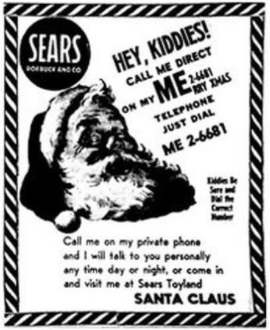In 2004, Google launched its Santa Tracker. What started as a small project soon took over the Santa Tracking business. Since then, it has become a popular website, receiving 500K visitors this past August. It is now considered one of the most recognizable holiday marketing campaigns in history.
A brief history of Santa tracking
Using Santa’s image for marketing purposes is nothing new. Coca-Cola, for example, created an incredibly successful Christmas marketing campaign in 1931 popularizing the modern image of Ol’ St. Nick. Santa Tracking came to the scene in 1955, with a Sears ad campaign. Unfortunately for Sears, they printed the wrong number, which has kids calling into the Continental Air Defense Command Center (CONAD). In 1956, CONAD decided to officially track Santa, sharing his whereabouts through TV and Radio. In 1958, North American Aerospace Defense Command (NORAD) took over and became the leading Santa trackers, launching a website in 1997.
Google Entered the Santa tracking game in 2004. They had recently purchased Keyhole, now known as Google Earth, and created the Santa Tracker to market the then subscription-based service. In their first year, Google’s new site received 25,000 visitors and “wreaked havoc on [their] servers.” The next year, users increased 10 fold. Then, in 2007, Google teamed up with NORAD. They also added their Santa Cam videos to YouTube, which they acquired in 2006. In 2008, they added Santa Tracker to Google Maps. Google’s now has the most popular Santa Tracker. The website and phone app now include games, Santa’s social media, the Santa Cam, and a countdown to Christmas.
Santa Tracker as a marketing tool
Santa Tracker is first and foremost a marketing tool for Google. It was initially developed for Google Earth. It’s safe to say, this marketing strategy worked brilliantly, with Google Earth’s popularity peaking the following year.

Since then, Google has used its Santa Tracker not just to bring fun (and some education) to kids around the world, but also to showcase new products. Because the program is developed with the same tools third party developers use, Google can show off what those products can do and how they work together. In addition, Santa Tracker shows which tools need to be improved each year.
Santa Tracker also helps with internal marketing. While the original team was only a few people, it has since grown to dozens, with more volunteering every year. The current project lead, Andre Ferrate, called the project “Such a ‘Google’ thing.” and it adds to the reasons people would want to work for Google and help make it successful. this
Since beginning this project Google has grown, expanding its tools and growing its presence on the internet. While they have launched thousands of marketing campaigns, this campaign remains one of the most popular. Each year, Google’s Santa Tracker gets flooded with millions of visitors from around the world, enjoying all the games, videos, and Santa Selfies it has to offer. This marketing strategy, which started as a flyer from Sears featuring the wrong phone number, has turned into a family tradition worldwide. If that’s not successful marketing, I don’t know what is.



